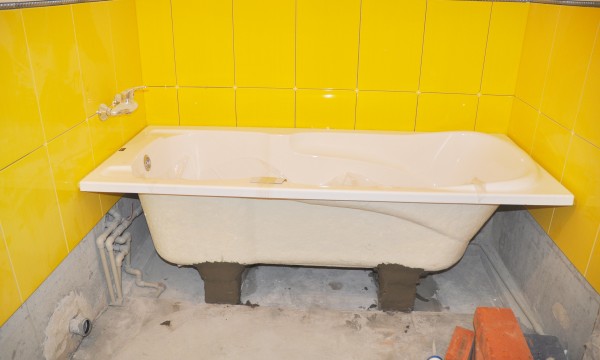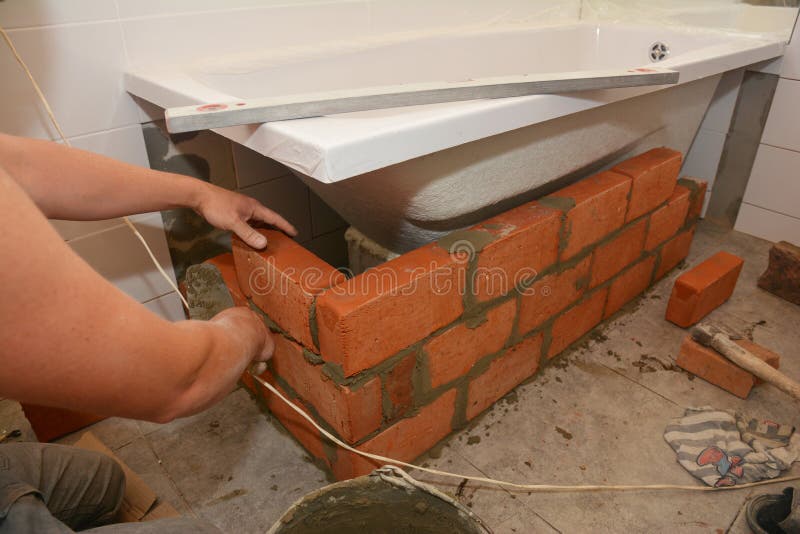Just about everyone has got their private piece of advice on the subject of Installing A Bathtub.

Installing a tub isn't specifically rocket science, however it does call for solid plumbing, carpentry, and also sometimes, tiling skills. Replacing an old bath tub with a brand-new one is also a reasonably hard task. If the old tub is easily obtainable, the project can move immediately; if you need to open up a wall to remove the old tub as well as place the brand-new bathtub, the task is much harder. In either situation, the task is within a residence handyman's abilities, although you will need a helper to leave the old tub and also embeded in the brand-new one. Make sure you have qualified yourself for the task as well as fit trying it. As opposed to working with a contractor to take over a halfway-completed project, it is better to consider employing one before you begin. Chances are you may need an expert plumber to make tube connections.
This post will certainly assist you set up a brand-new tub in your shower room if you have actually currently gotten a brand-new tub as well as don't need to alter the arrangement of your previous supply of water pipes.
Your tools and product list must make up the following:
Removing Old Taps
If you require to replace old faucets with brand-new ones as a part of your setup, then the first thing you should do is separate the water system. After doing so, activate the faucets to drain any kind of water continuing to be in the system. The process of removing the existing faucets can be rather problematic because of the restricted accessibility that is commonly the situation.
Use a basin wrench (crowsfoot spanner) or a faucet tool to undo the nut that connects the supply pipelines to the taps. Have a cloth ready for the staying water that will come from the pipelines. When the supply pipes have been gotten rid of, utilize the exact same tool to loosen up the nut that holds the faucets onto the bath/basin. You will require to quit the single faucets from transforming during this procedure. Once the faucets have been gotten rid of, the holes in the bath/basin will need to be cleaned of any kind of old securing compound.
Prior to proceeding to fit the brand-new taps, contrast the pipe links on the old faucets to the new faucets. If the old taps are longer than the new faucets, then a shank adapter is needed for the brand-new taps to fit.
Suitable New Taps
If the tails of the brand-new taps are plastic, after that you will need a plastic adapter to stop damage to the string. One end of the port fits on the plastic tail of the tap and the various other end offers a link to the existent supply pipelines.
If you need to fit a monobloc, after that you will call for decreasing couplers, which attaches the 10mm pipeline of the monobloc to the standard 15mm supply pipeline.
Next, place the tap in the placing hole in the bath/basin making sure that the washers remain in area between the faucet and the sink. Safeguard the faucet in place with the maker given backnut. When the faucet is safely in position, the supply pipes can be connected to the tails of the faucets. The taps can either be linked by utilizing corrugated copper piping or with typical faucet connectors. The previous type must be attached to the tap finishes first, tightening just by hand. The supply pipes can later be attached to the other end. Tighten both ends with a spanner after both ends have actually been linked.
Installing the Bathtub
Utilizing the two wood boards under its feet, place the tub in the called for position. The wood boards are helpful in uniformly spreading out the weight of the bath tub over the area of the boards rather than concentrating all the weight onto four small points.
The following goal is to guarantee that the bathtub is leveled all round. This can be accomplished by examining the spirit level and changing the feet on the tub till the level reviews level.
To set up faucets, fit all-time low of the outermost flexible tap port to the proper supply pipeline by making a compression join; then do the exact same for the various other faucet.
Switch on the water supply as well as inspect all joints as well as brand-new pipework for leakages and tighten them if required. Fill up the tub and likewise inspect the overflow electrical outlet and also the normal outlet for leaks.
Lastly, take care of the bathroom paneling as defined in the manufacturer's instruction manual. Tiling as well as sealing around the tub must wait up until the tub has actually been utilized a minimum of when as this will certainly resolve it into its final placement.
Planning for the Installment
To start with, the sustaining structure provided with the bathroom must be fitted (if required) according to the manufacturer's instructions. Next, fit the taps or mixer to the bathtub. When fitting the tap block, it is important to make sure that if the faucet features a plastic washing machine, it is fitted in between the bath as well as the taps. On a plastic bath, it is also reasonable to fit a sustaining plate under the faucets device to avoid stress on the bathtub.
Fit the flexible tap adapters to the bottom of both faucets utilizing 2 nuts and olives (often provided with the tub). Fit the plug-hole outlet by smearing mastic filler round the sink outlet opening, and afterwards pass the electrical outlet with the hole in the bath. Use the nut provided by the maker to fit the plug-hole. Take a look at the plug-hole outlet for an inlet on the side for the overflow pipeline.
Next off, fit completion of the flexible overflow pipe to the overflow electrical outlet. After that, screw the pipe to the overflow face which need to be fitted inside the bathroom. Make certain you use all of the provided washing machines.
Connect the catch to the bottom of the waste electrical outlet on the tub by winding the string of the waste outlet with silicone mastic or PTFE tape, and screw on the catch to the electrical outlet. Connect all-time low of the overflow tube in a comparable manner.The bathroom must now prepare to be fitted in its final placement.
Tiling Around the Tub
In the area where the bathroom meets the tile, it is needed to seal the accompanies a silicone rubber caulking. This is very important as the fitting can relocate enough to split a rigid seal, creating the water to penetrate the wall surface between the bath and the tiling, bring about problems with moisture and possible leaks to the ceiling listed below.
You can select from a variety of coloured sealers to blend in your components and fittings. They are marketed in tubes as well as cartridges, and also are capable of securing spaces approximately a width of 3mm (1/8 inch). If you have a bigger space to load, you can fill it with spins of soaked paper or soft rope. Bear in mind to always load the bathtub with water prior to sealing, to enable the movement experienced when the tub remains in use. The sealer can crack relatively very early if you do not consider this activity before sealing.
Conversely, ceramic coving or quadrant tiles can be utilized to border the bath or shower tray. Plastic strips of coving, which are easy to use and also cut to size, are also easily readily available on the market. It is suggested to fit the ceramic tiles making use of water-resistant or water resistant glue and grout.
Bathtub Installation
How Important Is A Bathtub To Your Home?
High-quality baths, showers, and other bathroom updates are necessary when considering a smart investment in your home. It’s a room that you go to every day and one that is constantly being used by guests.The bathroom is one of the top trafficked rooms in a home and also one of the most valuable in terms of home resale.
Install Piping Before Tub
You will be using your existing drain and waste vent system, but pipes required include the hot and cold water supply lines and a pipe leading to a shower head. A mixing valve and shower head are also needed. Air chambers may be required.
Position the Tub
Lower the tub into place so that the continuous flange fits against the wall studs and rests on 1’x4' or 2’x4' supports. Anchor the tub to the enclosure with nails or screws inserted through the flanges into the studs.
NOTE: Remember, bathtubs and shower stalls may require support framing. A bathtub filled with water is extremely heavy, so check building codes and framing support before installing the tub.
Assemble Drain Connections
Assemble the bathtub drain connections by connecting the tub overflow with the tub drain above the trap, not beyond it. The trap will have a compression fitting that screws over the arm of the overflow assembly.
Place a Pipe For the Shower Head
First, locate a brass female threaded winged fitting and attach it to a framing support via a screw or a nail. Then run a pipe up the wall for the shower head. Sweat or solder the other side of the brass fitting to the top of the pipe.
Attaching Hot and Cold Water Lines
Attach your water lines for both hot and cold by sweating these directly into the hot and cold ports of the mixing valve. The mixing valve will be how water enters the tub’s system, not by the pipes themselves.
Install the Spout
Extend a piece of 1/2 inch pipe, or whichever length is specified in the manufacturer’s instructions, for the tub spout. Sweat on a male threaded fitting at the end of the pipe or use a brass nipple of the proper length and a 1/2 inch cap.
NOTE: At this point you should have your rough-in plumbing work inspected before proceeding further.
Check For Leaks
Restore the water pressure and check the drain connection and the supply pipes for any sign of leaking.
estore the Bathroom Wall
Replace the wall with moisture-resistant drywall as a base for your wall covering. Seal the joints between the wall and your new tub with silicone caulk as protection against water seepage.
https://www.berkeys.com/2016/12/02/bathtub-installation-dallas/

I'm just very curious about Installing A Bathtub and I hope you appreciated the new entry. Enjoyed our write up? Please share it. Let other people discover it. Thank you so much for going through it.
Free Quote